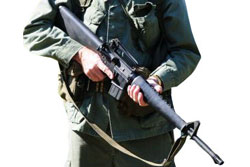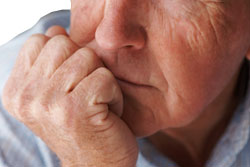Post-traumatic stress disorder (PTSD): Tom’s heart of darkness
- ‘My Experience’: PTSD: Tom’s heart of darkness
- More information on post-traumatic stress disorder
- More information on psychology and psychotherapy
PTSD: Tom’s heart of darkness
Unfortunately for the courageous young men surviving the horror of the Vietnam War with unimaginable mental and emotional scars, post-traumatic stress disorder (PTSD) was not formally recognised until 1980. For Tom, this meant nearly a lifetime of repressing painful memories until, finally, he was given the help he needed and so rightly deserved. However, PTSD doesn’t only affect soldiers. For any person experiencing an intense traumatic event, especially in the wake of the many recent natural catastrophes, facing the past may be the first step towards releasing it.
A war beyond words
Tom was badly injured several months into his tour of duty. “I could feel something was wrong, I felt a sort of premonition,” he says of the evening just before his unit was all but demolished by enemy fire.
 “Of a group of 18 men, five were killed and eight more wounded in the space of just two hours. We were just obliterated.”
“Of a group of 18 men, five were killed and eight more wounded in the space of just two hours. We were just obliterated.”
During this merciless battle, occurring after the infamous attack on the embassy in Saigon, Tom’s jaw was practically ripped open and his leg was badly wounded from what he believes was either a grenade or satchel bomb.
“I remember waking up and being very sore; there were bits and pieces missing from my jaw. And the bodies lying around me were like pin cushions.”
Part of the bomb hit Tom’s lower jaw and took out some bone and a lot of skin. Another part went into his leg and travelled nearly all the way up to his groin.
“That one only came out three years later.”
Home, strange home
Tom was in the hospital for nearly a month after that.
“My jaw was wired up in five places and I could walk on my leg with a limp and a lot of pain,” he says.
“We flew back and there wasn’t even anyone to meet us at the airport; we had to find our own way home.”
At the time, this was customary for Vietnam vets. Tom says there was not even a public or political acknowledgment of the mishandled approach to the battle that got his mates killed. Coupled with this repression in social communication was the repression of individual communication. PTSD was referred to as ‘shellshock’ and was little understood in the medical or social consciousness.
Carrying a heavy burden
 To deal with this inability to articulate or communicate, Tom started shutting down.
To deal with this inability to articulate or communicate, Tom started shutting down.
“I withdrew socially. I withdrew from everyone, even family and friends. I started acting out a bit, was quite aggressive and very angry. Most of the time I would just walk off.”
Tom also suffered crippling nightmares of the scene where his unit was attacked.
“The attack is always the same but the scenery changes. If I’m holidaying at Rottnest, for example, the soldiers would come and get me out of the ocean.”
The wound to his jaw also left him with violent seizures, so Tom was still dealing with physical pain, adding to his turbulent inner state.
Pain will out
Tom returned from the war to Australia in 1968. It was only in 1987, when Tom attended the Vietnam Commemoration March in Sydney, nearly 30 years later, that he started to face his pain.
“I came back from the parade and I knew something was wrong. I heard other blokes over there talking about this post-traumatic stress disorder and I didn’t even know what it was,” Tom says.
“Not long after, I had an interview with a professional specialising in PTSD. He works not only with vets, but also firemen, police officers or individuals caught in terrible situations.
“I revealed my story and he immediately told me I was suffering, quite severely, from PTSD.
“He prescribed me with medication which I still take if necessary, especially because I still suffer from nightmares.
“While it was a relief, it was a double-edged sword because then I had another problem.
“Facing it was a huge challenge in itself.”
The path to peace
 Tom says healing is a process and is also about maintenance. While he still suffers some PTSD symptoms, he has come an incredibly long way. His wife says that in the past he could never even talk about his experience with anyone at all.
Tom says healing is a process and is also about maintenance. While he still suffers some PTSD symptoms, he has come an incredibly long way. His wife says that in the past he could never even talk about his experience with anyone at all.
“And now I talk to school children and the public,” Tom says.
Tom still sees his mental health professional and has decided to retire from work to alleviate even more pressure from his life. He says that while it’s slow progress, he feels much better for facing it.
“The person who really pulled me through was my wife, she’s been tremendous,” he says.
“I’m in the RSL, which I never was before, and even go to the parades through her encouragement. I go to the gym and she makes sure I go. It makes me feel better as a whole and I feel more connected.”
Tom says his advice to anyone who has suffered a traumatic event is to seek out a professional.
“Just find someone you connect with, who knows what they’re talking about and who you like.”
More information
 | For more information on post-traumatic stress disorder, including risk factors, statistics, progression, diagnosis and treatment, see Post-Traumatic Stress Disorder (PTSD). |
 | For more information on psychology and psychotherapy, including different types of therapy, see Psychology and Psychotherapy. |
References
Dates
Created by:

 Login
Login














